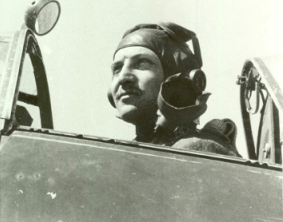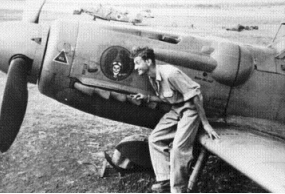 Ezer Weizman was born in Tel Aviv in 1924, and raised in
Ezer Weizman was born in Tel Aviv in 1924, and raised in
He began his long military career by enlisting in the British Army in
After his discharge from the RAF, Ezer attended
On his return to Mandatory Palestine, Weizman was one of a handful of pilots who founded the “Air Service” of the Haganah. Ezer commanded the Negev Air Unit of Piper Cubs based at Dorot, near Kibbutz Nir-Am.
On 29th May 1948, Ezer flew in a formation of four Avia S-199s which carried out the IAF’s very first combat fighter mission in a low-level attack on the Egyptian Army, which had already advanced to the Ad Halom Junction near the Arab town of Isdud (Ashdod), less than
This formation was led by Lou Lenart, an experienced American combat pilot. The two Israeli pilots who flew on this mission were Ezer Weizman and Modi Alon. Eddie Cohen, a South African pilot, was shot down and killed by Egyptian anti-aircraft fire. The next day, Ezer, together with American Milton Rubenfeld, attacked an Iraqi column approaching Kfar Yona. Rubenfeld’s S-199 was hit by anti-aircraft fire, and he was forced to fly out to sea, where he ditched his aircraft on the beach at the

The Czechoslovakian Avia S-199, with its many idiosyncrasies and deficiencies, was a vastly inferior model of the famous World War II German Messserschmitt (ME-109). Ezer, an excellent pilot, was one of only four pilots not involved in crashing an Avia S-199.
On 7th January 1949, Ezer led a formation of four Spitfires which engaged a formation of 19
Link to “Spitfires over
In the early days of the war, a raid in a small Fairchild plane over
“OK, we’re going back,” said Katz after the despatch of the bottles. “No, no, we’ve got to draw their fire,” Ezer replied. “There’s no point in that,” argued Katz. “It’s good to worry them and to keep them awake,” was Ezer’s reply.
Katz then made his calculations. Machine gun fire could reach up to about 4,000/5,000 feet, and at 6,000 the plane is reasonably safe.
“Go lower, go lower,” Weizman told him, but when Weizman wasn’t looking, Katz increased the altimeter reading by an extra
A weary Katz landed at a Tel Aviv airfield three hours after take-off. Whilst taxiing along, Weizman noticed that the altimeter read
Before Sydney Cohen, the Commanding Officer of 101 Squadron, left the IAF in April 1949 to resume his medical studies in
Ezer mentioned frequently that he learned so much from Syd Cohen as a fighter pilot and as a squadron commander. When Syd left for
Throughout the years, Ezer expressed his appreciation and recognition of the contribution which the Machalniks made in founding and developing the IAF, and of Machal’s tremendous contribution to
Ezer was Commander Officer of the Israel Air Force from 1958 till 1966. He was Chief of Operations of the General Staff during the 1967 Six-Day War, and he was the architect of the IAF’s unparalleled victory over the Egyptian, Syrian, and Jordanian Air Forces in that war. He also served as Deputy Chief of the General Staff, and retired from military service in 1969.
On entering his political career, Ezer joined Menachem Begin’s Likud party, serving first as Minister of Transport and then as Minister of Defense. Together with Moshe Dayan, he was on Menachem Begin’s team at the
After a short term as a businessman, Ezer formed his own small independent party, Yachad, and returned to politics. He joined the government of National Unity led alternately by Shimon Peres and Yitzhak Shamir. He served as a government minister for six years.
In 1992 he again retired from active politics, and a year later he was elected as the 11th President of the State of Israel. He was re-elected in 1998 for a second term, but resigned in July 2000. Ezer Weizman passed away in April 2005.
Condolence letter from
to Ezer Weizman’s widow, Reuma
Dear Reuma,
On behalf of
The Machalniks deeply appreciated the ongoing friendly relations between Ezer and his Machal comrades, especially with the Machal personnel who served in 101 Squadron. During Ezer’s service in the IAF, or in his political life, or as the State President, he always had an open door and a welcoming smile for Machalniks.
His close friendship with Syd Cohen is particularly noteworthy. I will always remember the incident which took place in April 1949 concerning President Chaim Weizmann and Syd. The President was about to embark on his first formal visit to the
May you and all the members of your family be blessed with abundant good health and may Ezer rest in peace.
Warmest regards.
Sincerely,
Smoky Simon is Chairman of World Machal.
Source: Henry Katzew’s “

